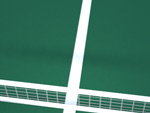Tennis

Volley
A volley in tennis is a shot in which the ball is struck before it bounces on the ground. Generally a player hits a volley while standing near the net, although it can be executed farther back, in the middle of the tennis court or even near the baseline. The word derives from M. French volée meaning flight.
The primary objective of the volley is to go on the offensive and cut the amount of time for the opponent to react. Another advantage is that a player eliminates any possibility of a bad bounce from an uneven surface such as on some grass and clay courts. Also, if near the net, a volleyer has a wider choice of angles to hit into the opponent's court. However, quick reflexes and hand–eye coordination are required to execute this shot. The primary means of countering a volley are the passing shot and the lob.
Generally, a player who advances to the net in the serve and volley type of game will make the initial volley fairly near the service line. The player will then move closer to the net in hopes of making a put-away volley for a winning point. It is difficult to hit an effective volley in the area between the baseline and the service line, consequently this is often called "no man's land".
Hitting a volley
A regular volley is hit with a short backswing and a punching stroke. While standing at the net, a player usually has no time to take a long backswing. When the ball comes at less pace, though, the volleyer can take a longer backswing to impart more force on the ball, which is called a swing volley. A player can also touch the ball lightly, so that the ball will fall just after the net. This is known as a drop volley.
Another type of volley is the drive volley. This is hit with more backswing and followthrough than a normal volley. Effectively this is a volley groundstroke and a very aggressive shot, giving your opponent less time, and can be used as a way to approach the net (approach shot).
To be effective and safe, a volley should be either (1) a drop volley that barely passes the net so the opposing player will not be able to get to it, or (2) a very sharply angled shot so that again the opponent will not be able to get to it, or (3) a hard shot that bounces very near both the opponent's baseline and the sideline and that serves as a set-up shot in anticipation of a weak return by the opponent. Any other volley will permit the opponent to get to the ball in plenty of time to make an aggressive return shot, either a lob or a passing shot.
The lower the ball comes at the volleyer, the harder it is to hit an effective volley. In some cases, a player is better off to let the ball bounce rather than attempt to volley it, then hit it on the rise right after the bounce. This is called a half volley (although technically it is not a volley) and is one of the most difficult shots in tennis; John McEnroe, Patrick Rafter and Leander Paes were considered masters of it.
SPORTS

RESOURCES
This article uses material from the Wikipedia articles "Tennis" and "Volley", which is released under the Creative Commons Attribution-Share-Alike License 3.0.
© Stories Preschool. All Rights Reserved.









